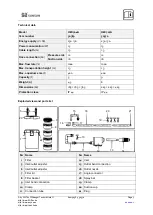
© by WilTec Wildanger Technik GmbH
Item 50369, 50370
Page 6
02 2022
-1
The filter material included in the scope of delivery is considered the standard for your external aquarium
filter.
Application is from bottom to top:
1. Stage: mechanical / partly biological filtration
2. Stage: biological filtration
3. Stage: chemical filtration (activated carbon, turf, phosphate, etc.)
Four stage filters can be complemented by another mechanical or biological filter stage, depending on
personal requirements.
Ceramic rings
Being suitable for internal and external aquarium filters, ceramic glass rings are filtering media for me-
chanical filtration, mainly used to remove suspended particles. As the rings create turbulences within
the water due to their special shape and large surface, floating dirt particles are accumulated and re-
moved from the water cycle. Additionally, the rings create an ideal environment for filter bacteria settle-
ment and thereby reduce the peak contamination caused by nitrite more effectively than common filter-
ing media.
Filter floss – filter fleece
Filter media such as fleece, floss, or sponges are an essential part of modern fish-keeping. Filter floss
and fleece can absorb coarse dirt particles while filter sponges reduce the nitrate levels of the water,
remove chemical pollutants, and create an ideal environment for filter bacteria.
Bio balls
Bio balls are used as both biological and mechanical filter media. Offering a large surface for bacteria
to settle on, these balls are considered high performance filter media, especially in large filter systems.
In contrast to most other filter media, bio balls offer a virtually unlimited lifespan, making them a popular
and cheap filter medium, especially for pond filter systems as well as trickle filters and chamber filters.
Activated carbon (optional)
Activated carbon is used to bind urinary and humid matter, pesticides, toxins as well as products of
metabolism and similar residues and thereby provide clean aquarium water. The use of activated carbon
further reduces the ozone and chlorine content of the water. It is particularly well suited for the pre-
treatment of tap water, for the removal of turbidity caused by suspended particles as well as for the
effective filtering of possible residue of medical treatments.
The use of activated carbon is not recommended during the duration of medical treatments or algae
control efforts. Its use, however, is essential once the treatment has ended as it is needed to reliably
remove residue from the water. It is further not recommended to leave activated carbon inside the filter
for too long, since the previously bound contaminants may be released into the water again, once the
intake capacity of the activated carbon has been exceeded
Please be aware that the beneficial bacteria must be accumulated again after the new acquisition of an
aquarium or a thorough cleaning of the same. Special bacteria cultures can be placed inside the aquar-
ium filter to facilitate the growth of beneficial bacteria.









